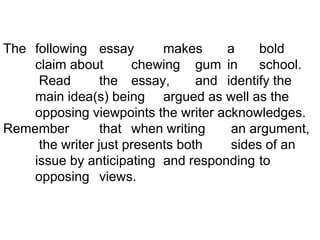Begin year writing assessment 2014 2015
- 1. You may have experienced an argument as an angry quarrel or disagreement. A formal argument, however, is a well-reasoned presentation of facts and details to support a claim with the goal of persuading others to accept a stated point of view. Think about a time when you ŌĆ£arguedŌĆØ or made a claim to be allowed to do something. What was your claim, and what reasons did you use to support it?
- 2. The following essay makes a bold claim about chewing gum in school. Read the essay, and identify the main idea(s) being argued as well as the opposing viewpoints the writer acknowledges. Remember that when writing an argument, the writer just presents both sides of an issue by anticipating and responding to opposing views.
- 3. As you read this text, identify the writerŌĆÖs viewpoint and highlight the claim being made. Underline the evidence that supports that claim. Circle anything that suggests ideas that are opposed to the writerŌĆÖs viewpoint.
- 4. To Chew or Not to Chew Is it right to ban gum in school? Many people would agree that gum should be banned. Nasty gum stuck in unlikely places is a nuisance for both teachers and students. Teachers and administrators alike say it is distracting, and it creates a janitorial nightmare. But wait-if schools are interested in improving student achievement, they will rethink their policy against chewing gum. Research shows that chewing gum actually improves learning by increasing brain activity and focus. Gum chewing helps students stay alert and ready to learn. Students in my classes sometimes have trouble staying awake, much less keeping alert. If they chew gum, the movement of the jaw can help keep students awake. Even better, research done by Kathleen Melanson, from the University of Rhode Island, has shown that chewing gum raises your metabolism by 20 percent (www.medicalnewstoday.com). This increase in metabolism shows a direct link between physical alertness and chewing gum. Some people think that gum is an unhealthy habit, but when examined closely this idea is not supported by research. As a matter of fact, gum is a healthy option to avoid overeating. Others say that chewing sweet gum causes tooth decay. However, many gums contain xylitol, which makes them sugar free. Research by the Trident Company, a chewing gum manufacturer, shows that chewing sugar-free gum can reduce cavities by 70 percent. According to Trident, chewing gum is like chewing fluoride in its cavity- prevention power.
- 5. Most importantly, gum promotes learning by helping students work better and longer. The Wrigley Company, which has produced chewing gum for decades, claims that soldiers have chewed gum since World War I to improve concentration during stressful situations. In addition, research conducted by the American Society for Nutrition found that students who chewed gum during class over a 14-week period had a significant increase in test scores and received a better final grade compared to those who had not chewed gum. By now it should be clear that chewing gum has real benefits. One last piece of evidence indicates chewing gum increases brain power and the ability to concentrate. Chewing gum makes the brain think it is going to get food. As a result of this chewing motion, research has shown that insulin, which enhances learning and memory, is released to the brain and helps it to concentrate and focus (Andrew Scholey, Swinburne University, www.medicalnewstoday.com). Students do not have to chew gum to do well in school, but the evidence clearly shows that chewing gum may help students do better in school. Schools should do all they can to support student learning. Please urge our school administration to change its thinking on banning gum in school.
- 6. When you have finished reading, respond to the questions below in the space provided. Be prepared to discuss your answers with your classmates. a. Purpose: What is the writerŌĆÖs purpose for writing this argument? (Refer to the sentence in the first paragraph that you highlighted for the claim or thesis of the essay.) b. Audience: Who do you think the writer had in mind as an audience for this argument? To whom do the reasons and evidence seem addressed? How do you know? c. Support: What facts, examples, and personal experiences does the writer present as evidence to support the argument? What evidence is most relevant and effective, and why? d. Opposing Viewpoints: What opposing viewpoints does the writer offer? e. Organization: How does the thesis statement set up the organization of the essay? f. Transitions: What words does the writer use to connect thoughts and guide the reader through the essay? g. Sources: What sources does the writer cite? How do those sources support the writerŌĆÖs claim with relevant evidence? Do the sources appear credible? How does the source of the evidence affect its relevance?















